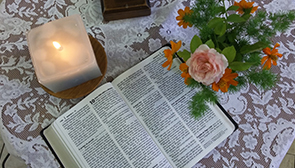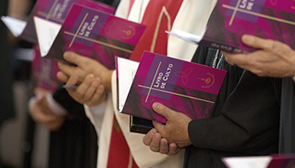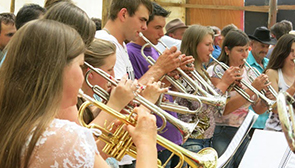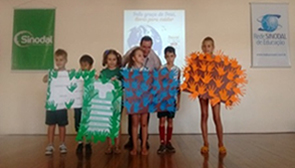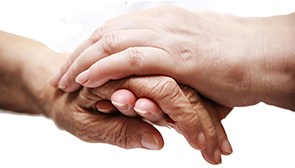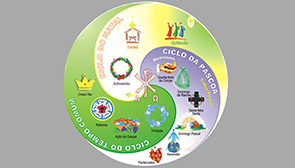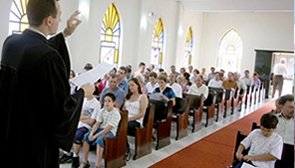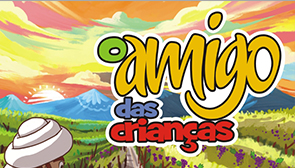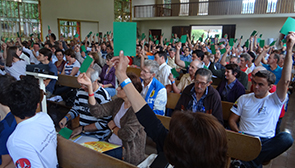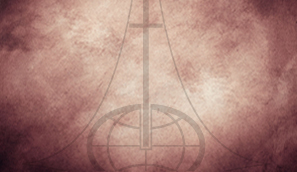
Jacob and Esau – a journey of reconciliation
Rev. Dr. Elaine Neuenfeldt, ACT Alliance Gender
1) Daily life and the challenge of reconciliation
To concretely speak about peace and reconciliation at this juncture is a challenging task. It is not easy to bring reconciliation and peace in the midst of the current reality, which is filled with hate and violence. Hate speech is considered “freedom of expression”. Exclusion and discrimination based on peoples backgrounds, economic situation and gender identities are becoming normalized in some contexts; and unfortunately, sometimes, these are justified in the name of religion.
Fundamentalist interpretation of religion is providing a platform for violent and extremist practices of using (or misusing) religion and faith as weapons to exclude and eliminate those who are non-conforming to a social, economic, political and cultural order. There is a need to continue questioning and debating about theological positions and faith understanding that are contributing to division, judgement and discrimination. If faith is used to separate the world in “us” and “them”, in “we, the good people and ”them” the “bad” then our critical antennas of instrumentalizing faith should be activated.
2) How to think reconciliation in this context?
How can we talk about values and beliefs that promote peace, acceptance and inclusion, in the context of our faith? What can an ancient Bible text as the saga of Jacob and Esau narrated in Genesis 25-36 tell us about reconciled relationships in our contemporary context?
I invite you to follow a journey of reconciliation – and not only focus on the single event as narrated in Gen 33. 1-16; in this journey, I want to propose some steps that promote a reconciled relationship with God and with the other.
Esau and Jacob started their quarrel in their mother’s womb. Genesis 25 tells us that Rebecca did not have a good pregnancy – she suffered; she asked God why she had to feel this pregnancy as a troubled time and not as a blessed time. The answer is that she had two nations in her womb: “and the two peoples born shall be divided; the one shall be stronger and the elder shall serve the younger” (25.23). The saga of Jacob and Esau is a story of struggle, competition and division. It’s not a story of peace. A story of brotherhood that is experienced as fight and conflict.
The conflict culminates with the loss of the rights by the firstborn and the blessing connected to it. Jacob is the one described as calm and sympathetic. Esau is presented as a redhead – even though the iconography shows him with brown or black even, hairy and suggesting he is culturally ignorant.
The image that the story portrays is clear: Jacob, is fair and presented as a good guy while Esau, with brown-skin is hairy and unkind or ignorant.
A very much colonialist way of interpreting the text. This has influenced also how we interpret the story of the encounter of the two brothers and how we understand reconciliation, which can be a dangerous word and act if disconnected from a power analysis.
What does reconciliation mean for a poor person with his or her rights denied, living in a social and political region in Africa or LAC, with no power to negotiate better work conditions; or to a capitalist manager of an international corporation responsible to establish a mine company in Peru; or to a woman who suffered sexual and gender- based violence by her intimate partner who is the only provider, or bread winner in the family? Does reconciliation mean the same thing to privileged as it does to the deprived?”
How to deconstruct this? First, we need to understand the conflict, what are the causes and why reconciliation is needed, and how it can/should happen. What are the implications of reconciliation, what actions are required from each party involved to achieve true reconciliation?
3) The conflict – what are the causes and how to deal with them, to reconcile
It is tempting to read the saga of these two brothers in a polarized way, keeping our binary lenses of us/good and them/bad and interpreting the story in a way that will reinforce fundamentalist categories. Jacob, the good, the calm and the one who knows how to use opportunities and Esau, the hairy redhead, the indelicate, the one who doesn’t care about what he was given in life. But easy dichotomy has brought so much damage, justified racism, discrimination and hierarchical power relations. Jacob a nation, Israel and Esau, the others in conflict, the Edomites/ Edom. Therefore, it justified power relations not only among individuals, but among groups, among peoples and nations.
So, let us complicate this story and see if it helps us find new ways to interpret the conflict between the two brothers, which was a metaphor for a conflict between two nations.
Normally, we know that Esau sold his first born right for a plate of lentils soup. (I can imagine that it was a feijoada… a good brasilian black beans soup).
However, what if we look at the same scene from another angle?
Esau is a hunter, and he arrived home empty handed. Maybe there was a period of scarcity, and due to this shortage, he was hungry. Jacob used this as an opportunity to negotiate what he most wanted from his brother: the first born right. To negotiate he used food! Ora ora… when someone is hungry, it is easy to persuade him/her and get what you want. Jacob is using food and rights as commodities. Negotiating from his privileged position with someone who is deprived of power because of hunger.
Esau answered: “I am about to die, of what use is a birthright to me?” (Genesis 25.32) This was how this event was interpreted through history: Esau scorned his rights, he undervalued God’s gift of having been born first. The narrative itself and the interpretation normally blamed Esau for underselling his right for a plate of lentils.
It is so common to hear colonialist interpretations of poverty especially for the global south and judge the lack of education and lack of knowledge as a disgrace. It is this colonialist understanding that blames the poor for their poverty and lack of profiting from opportunities, rather than seeing a system that is built to produce exclusion and discrimination.
4) But… what about Jacob’s lack of solidarity?
His brother was hungry and he, instead of giving him food, sharing what he had, he negotiated using the other’s vulnerability. This greedy attitude lead Jacob to the next step – conspiring a plan with his mother, Rebecca, to steal Esau’s blessing. Using again the fragility of an aged father, he disguised himself taking the place and the rights of his brother. This escalated the conflict to the point that Jacob was obliged to flee to another land. Esau hated him and wanted to kill him.
This story is permeated by envy and cheating to get the prize. Rivalry stems from greedy and covetous desires, using tricks and fraud. Amid this mess, how can a story of reconciliation of these two brothers emerge? What can reconciliation mean?
5) The reconciliation journey
For many years after Jacob fled, he worked for his father-in-law, Laban, in a foreign land, trying to form a family. He was tricked into a relationship with the older daughter, Leah, with beautiful eyes, first. Then, he worked 7 more years to finally marry Rachel, the one he loved. But he still could not find peace. Laban was not treating them well; he was trying to benefit from Jacob’s work. So, Jacob had to flee again with family and flocks. The whole family left – but, as it now becoming a habit, not without another trick. Rachel stole the domestic deities, those who protected the house and ensured the blessings of wealth.
6) Revisiting and dealing with memories
At this point, Jacob wants a new life and goes back to the place where he was born and where the main conflict with his brother took place. But he knows that he cannot start anew, without resolving the problems originated in the past. These memories of a conflictive childhood and the ruined relationship with his brother would not go away without accountability.
So, the journey of reconciliation includes revisiting the memories of the past. Facing them. Dealing with them. It requires lifting the face up to see the person we caused pain and suffering. Hurt by our attitudes. Excluded and discriminated by the system.
In Latin America, we have gone through this process. We have summoned the memories of the past and we have held ourselves accountable. Our memories are populated by pain and suffering, persecution and violence of military dictatorship. Being Brasilian and having lived in Central America has taught me these lessons – “perdonar pero no olvidar” – “forgive but not forget.” The past cannot be forgotten or denied. The healing process must revisit the past, but one should not remain tied in the past. Forgiveness includes revisiting these painful memories, not being kept captive by them. It is walking this thin line of remembering without allowing it to hinder or hamper our moving forward.
To connect with the theme discussed in this synod: “How to be (come) a just peace church” “Auf dem Weg zu einer Kirche der Gerechtigkeit und des Friedens” I would remind us that churches do have a crucial role in building peace with justice. Churches and faith-based organizations are working at community level, and have a crucial role to re-build social fabric in times of conflict disruption. Church leaders can influence social and cultural beliefs, and can be a trustful voice in building bridges between different groups. Faith communities are congregating people of different belongings, and can be catalyzers of different interests. Faith is a powerful element to help people to keep hope and re-built lifes.
What are your own memories that need to be revisited? What are the situations in your own life, family and community that are there to be dealt with, to be brought to accountability in order to go through the healing process?
7) Before encountering the brother, the encounter is with God!
As the reconciliation journey continues, there is another strong, powerful, mysterious encounter. The night before meeting his brother, Jacob is by the river, and wrestled with someone. His body, full of memories, full of anxiety of what will happen the next day, experienced wrestling with a stranger, whom he recognized as God. Jacob again, asked for blessing – and remembered the place naming it according to his experience – Peniel – Pana – the face of El, God. Before seeing the face of his brother, Jacob had to look to the face of God! Reconciliation is a spiritual journey of prayer and dialogue with God. It is being marked by God’s mercy, which leads to a movement to find the other.
A moment of silence to pray, bringing in the presence of God, all our pain, sufferings of the people with whom we work and live.
8) Genesis 33. 1-17 is narrating this reconciliation moment.
The encounter is full of emotions and body language. Jacob comes with all his family, wives, children and flocks. Maybe this is the only way he knows to impress his brother – kind of saying: Look, Esau, what I have done with the blessing I have stolen from you! It was worth to steel! I have grown in numbers, in age and in wealth.
Then Jacob, bowed down 7 times. 7X – seven… it is such a powerful number… how many times you need to forgive your brother, your sisters, 7 times 7… (well, as brasilian there is another 7 that I remember: when Germany has beaten Brasil football in the world cup, for 7X1!!! But, let’s not talk about this unfortunate moment now.
Bowing down is a sign of recognition of Esau’s authority and even superiority. Jacob calls Esau, my lord; while Esau, calls Jacob, my brother.
Esau runs to meet Jacob; called him by his name, embraced him, fell on his neck, kissed him.
They both wept.
What emotional scene. Full of love, repentance, tenderness, vulnerability. There is no place for bringing the past in front, as their only wish is to embrace and to reconcile. The painful past was still there – but was not an impediment to reconcile, to embrace, and to accept. Reconciliation means bringing past memories to the front. Sometimes our reason would argue: First, you need to talk about the past, what happen and clean it, solve it…and then embrace. It seems that in a reconciliation process words and discussions are not so much pushed to the front. Arms, bodies, feelings, emotions take a primary place; are providing the space for healing and encounter the other.
Then Jacob can affirm: for truly to see your face is like seeing the face of God.
It is in the reconciled brother that God’s face is revealed. It is by truly loving your brother, your sister, your neighbor that you see, or you know God.
At this moment, the whole group of people are involved in the reconciliation of the two brothers. Women and children are coming to the front; they are walking to embrace this moment. Women and children know what conflict brings to their life. They are most affected in conflicts and war. They urge reconciliation to happen.
Words come later, in the form of a dialogue about gifts and offerings. Again, it is from Esau that we learn that he is not expecting repair, material goods to compensate the hurt in the past. Esau said he has enough. It does not say how much he has… but, for him, it is enough.
One final word about what happen after the encounter. Esau offered hospitality. Jacob was not prepared to follow his brother. He said that they would come together again in Seir, in the South, where Esau lived. But Jacob went to north, to Succoth and established home there. Yes, there is Jacob, lying again to his brother. Going in another direction than he promised. And maybe this was needed for him… because he felt he could do this…and the text is not telling us that Esau felt sad or disappointed. It might be that reconciliation is like this… a coming and going in trust and fear, in confidence and insecurity, never fully in control of what will happen in the future. It is in the midst of these fears and doubts that God’s offer grace and mercy; even with this deceitful character Jacob continues to be blessed by God and reconciled with his brother.
Reconciliation is a journey, not an event. It needs to be a movement that happens again and again, as human beings are sinful and live broken relations. Reconciliation is a movement, a learning process, where we need to learn, to give and to receive, to be open, and to offer… like a dance.
9) A poem
An Arab Christian Palestinian writer Elias Chacour:[1]
The true icon is your neighbour, the human being who has been created in the image and with the likeness of God. How beautiful it is when our eyes are transfigured and we see that our neighbour is the icon of God, and that you, and you, and I – we are all the icons of God. How serious it is when we hate the image of God, whoever that may be, whether a Jew or a Palestinian. How serious it is when we cannot go and say, ‘I am sorry about the icon of God who was hurt by my behaviour.’ We all need to be transfigured so we can recognise the glory of God in one another.
10) A movement
- Invite people to stand and put hand in a prayer position: /
- Then invite to open their hands so that the left hand is open – as receiving and the right hand is down – as giving.
- If they want and feel comfortable, invite each one to reach the hand of their neighbor --- experience the movement – like a dance of giving and receiving
-
With music (to play a song while doing this)
[1] Elias Chacour We Belong to the Land, Collegeville: University of Notre Dame Press, 2001, p.46-47. Taken from: CLARE AMOS. Christ is our reconciliation: a scene from an icon of peace. Rethinking mission. 2005. P. 29.


